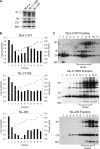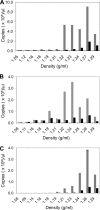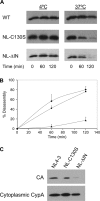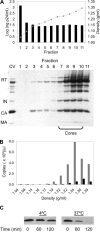Role of human immunodeficiency virus type 1 integrase in uncoating of the viral core
- PMID: 20219923
- PMCID: PMC2863833
- DOI: 10.1128/JVI.02382-09
Role of human immunodeficiency virus type 1 integrase in uncoating of the viral core
Abstract
After membrane fusion with a target cell, the core of human immunodeficiency virus type 1 (HIV-1) enters into the cytoplasm, where uncoating occurs. The cone-shaped core is composed of the viral capsid protein (CA), which disassembles during uncoating. The underlying factors and mechanisms governing uncoating are poorly understood. Several CA mutations can cause changes in core stability and a block at reverse transcription, demonstrating the requirement for optimal core stability during viral replication. HIV-1 integrase (IN) catalyzes the insertion of the viral cDNA into the host genome, and certain IN mutations are pleiotropic. Similar to some CA mutants, two IN mutants, one with a complete deletion of IN (NL-DeltaIN) and the other with a Cys-to-Ser substitution (NL-C130S), were noninfectious, with a replication block at reverse transcription. Compared to the wild type (WT), the cytoplasmic CA levels of the IN mutants in infected cells were reduced, suggesting accelerated uncoating. The role of IN during uncoating was examined by isolating and characterizing cores from NL-DeltaIN and NL-C130S. Both IN mutants could form functional cores, but the core yield and stability were decreased. Also, virion incorporation of cyclophilin A (CypA), a cellular peptidyl-prolyl isomerase that binds specifically to CA, was decreased in the IN mutants. Cores isolated from WT virus depleted of CypA had an unstable-core phenotype, confirming a role of CypA in promoting optimal core stability. Taken together, our results indicate that IN is required during uncoating for maintaining CypA-CA interaction, which promotes optimal stability of the viral core.
Figures






Similar articles
-
Identification of capsid mutations that alter the rate of HIV-1 uncoating in infected cells.J Virol. 2015 Jan;89(1):643-51. doi: 10.1128/JVI.03043-14. Epub 2014 Oct 22. J Virol. 2015. PMID: 25339776 Free PMC article.
-
Cyclophilin A promotes HIV-1 reverse transcription but its effect on transduction correlates best with its effect on nuclear entry of viral cDNA.Retrovirology. 2014 Jan 30;11:11. doi: 10.1186/1742-4690-11-11. Retrovirology. 2014. PMID: 24479545 Free PMC article.
-
A new functional role of HIV-1 integrase during uncoating of the viral core.Immunol Res. 2010 Dec;48(1-3):14-26. doi: 10.1007/s12026-010-8164-z. Immunol Res. 2010. PMID: 20721640
-
May I Help You with Your Coat? HIV-1 Capsid Uncoating and Reverse Transcription.Int J Mol Sci. 2024 Jun 28;25(13):7167. doi: 10.3390/ijms25137167. Int J Mol Sci. 2024. PMID: 39000271 Free PMC article. Review.
-
Multiple Roles of HIV-1 Capsid during the Virus Replication Cycle.Virol Sin. 2019 Apr;34(2):119-134. doi: 10.1007/s12250-019-00095-3. Epub 2019 Apr 26. Virol Sin. 2019. PMID: 31028522 Free PMC article. Review.
Cited by
-
Virus-producing cells determine the host protein profiles of HIV-1 virion cores.Retrovirology. 2012 Aug 13;9:65. doi: 10.1186/1742-4690-9-65. Retrovirology. 2012. PMID: 22889230 Free PMC article.
-
Impairment of human immunodeficiency virus type-1 integrase SUMOylation correlates with an early replication defect.J Biol Chem. 2011 Jun 10;286(23):21013-22. doi: 10.1074/jbc.M110.189274. Epub 2011 Mar 21. J Biol Chem. 2011. PMID: 21454548 Free PMC article.
-
Superresolution imaging of HIV in infected cells with FlAsH-PALM.Proc Natl Acad Sci U S A. 2012 May 29;109(22):8564-9. doi: 10.1073/pnas.1013267109. Epub 2012 May 14. Proc Natl Acad Sci U S A. 2012. PMID: 22586087 Free PMC article.
-
The N-end rule and retroviral infection: no effect on integrase.Virol J. 2013 Jul 13;10:233. doi: 10.1186/1743-422X-10-233. Virol J. 2013. PMID: 23849394 Free PMC article.
-
Multifaceted HIV integrase functionalities and therapeutic strategies for their inhibition.J Biol Chem. 2019 Oct 11;294(41):15137-15157. doi: 10.1074/jbc.REV119.006901. Epub 2019 Aug 29. J Biol Chem. 2019. PMID: 31467082 Free PMC article. Review.
References
Publication types
MeSH terms
Substances
Grants and funding
LinkOut - more resources
Full Text Sources
Other Literature Sources

